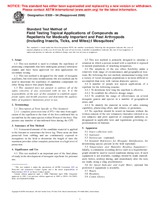Wir benötigen Ihre Einwilligung zur Verwendung der einzelnen Daten, damit Sie unter anderem Informationen zu Ihren Interessen einsehen können. Klicken Sie auf "OK", um Ihre Zustimmung zu erteilen.
ASTM E939-94(2006)
Standard Test Method of Field Testing Topical Applications of Compounds as Repellents for Medically Important and Pest Arthropods (Including Insects, Ticks, and Mites):I Mosquitoes
Automatische name übersetzung:
Standard Test Method of Field Testing topische Anwendungen von Verbindungen, die als Repellentien für medizinisch wichtigen Arthropoden und Pest (einschließlich Insekten , Zecken und Milben ): I Mücken
NORM herausgegeben am 1.4.2006
Informationen über die Norm:
Bezeichnung normen: ASTM E939-94(2006)
Anmerkung: UNGÜLTIG
Ausgabedatum normen: 1.4.2006
SKU: NS-48535
Zahl der Seiten: 5
Gewicht ca.: 15 g (0.03 Pfund)
Land: Amerikanische technische Norm
Kategorie: Technische Normen ASTM
Die Annotation des Normtextes ASTM E939-94(2006) :
Keywords:
effective dosage range, efficacy, field testing-environmental, insecticides, insects, mites, mosquitos, repellant compounds, skin-irritancy/disease, ticks, field testing topical applications of repellant compounds for mosquitoes, ICS Number Code 71.100.99 (Other products of the chemical industry)
Ergänzende Informationen
| Significance and Use |
|
This test method is an important part of the final phase of study in the development of mosquito repellents for personal use. This test method is primarily designed to simulate a situation in which a person treated with a repellent is exposed to natural populations of attacking mosquitoes. The simplicity of the test offers flexibility under a relatively wide range of circumstances and geographical locations. By following this test method, international testing with a variety of vector mosquito populations is no more difficult to accomplish than tests with various domestic species. A number of people test topical applications of a repellent for the following reasons: 4.4.1 To determine how long the repellent is effective; 4.4.2 To establish the effective dosage range; 4.4.3 To establish the range of effectiveness on several mosquito genera and species in a number of geographical areas; and 4.4.4 To identify the material in terms of odor, staining capability, plasticizing effect, and oiliness or greasiness. No repellent should be tested on humans without the written consent of the test volunteers (hereafter referred to as test subjects) and prior approval of competent authority, as designated in applicable laws and regulations governing experimentation on humans. |
| 1. Scope |
|
1.1 This test method is used to evaluate the repellency of promising compounds that have undergone primary laboratory studies and have been approved for skin application for secondary testing. 1.2 This test method is designed for the study of mosquito repellents, but with some modifications this test method can be used to determine the repellency of candidate compounds for other flying insects that attack humans. This standard does not purport to address all of the safety concerns, if any, associated with its use. It is the responsibility of the user of this standard to establish appropriate safety and health practices and determine the applicability of regulatory limitations prior to use. |
Empfehlungen:
Aktualisierung der technischen Normen
Wollen Sie sich sicher sein, dass Sie nur die gültigen technischen Normen verwenden?
Wir bieten Ihnen eine Lösung, die Ihnen eine Monatsübersicht über die Aktualität der von Ihnen angewandten Normen sicher stellt.
Brauchen Sie mehr Informationen? Sehen Sie sich diese Seite an.




 Cookies
Cookies
